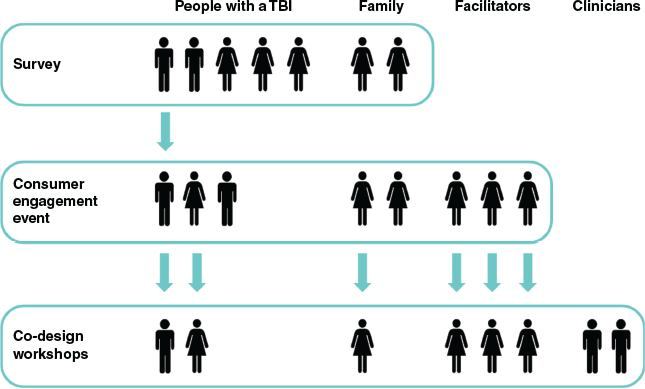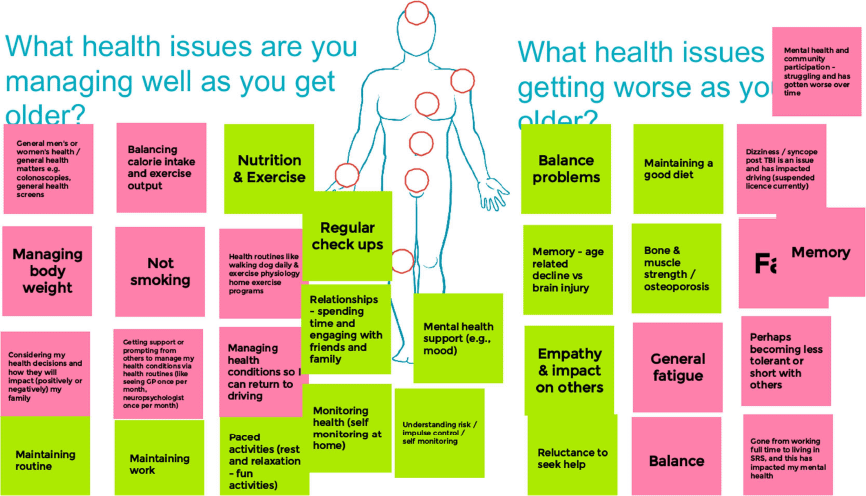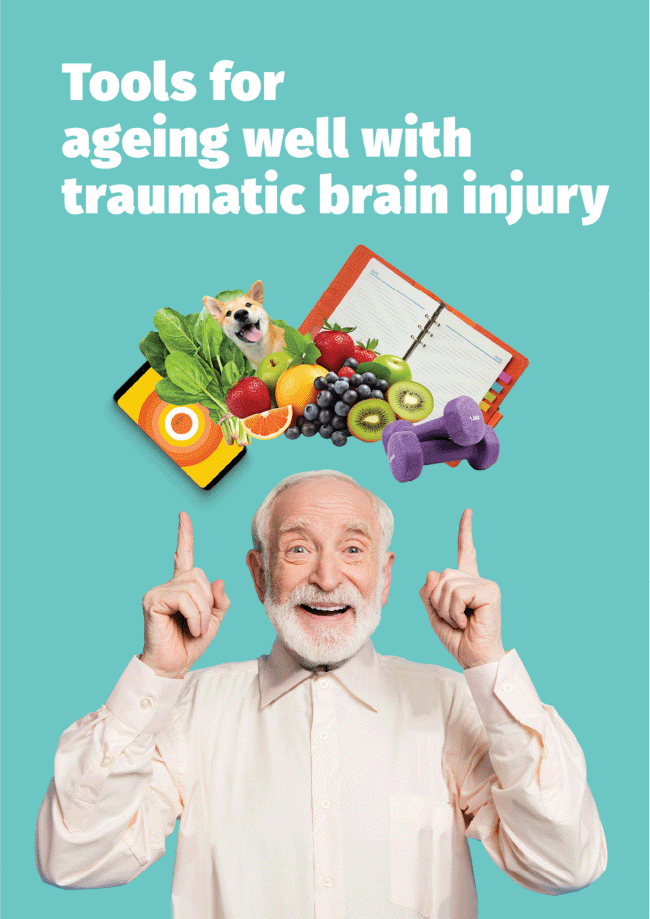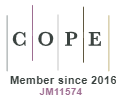Co-design and co-production of ‘Tools for ageing well with traumatic brain injury’
Christina L. Ekegren A * , Candice McBain
A * , Candice McBain  B C , Libby Callaway
B C , Libby Callaway  A D , Liz Gill B C , Grahame Simpson B C E , Grainne Cruickshank A , Mohit Arora B C and Ian D. Cameron B C
A D , Liz Gill B C , Grahame Simpson B C E , Grainne Cruickshank A , Mohit Arora B C and Ian D. Cameron B C
A
B
C
D
E
Abstract
Despite experiencing complex health needs, there are limited targeted resources to assist older adults with traumatic brain injury (TBI) to age well. This report aims to describe the co-design and co-production of a tailored resource designed with, and for, older people with TBI, their families/carers, and health professionals working with them.
A five-stage design-thinking process was followed, incorporating ‘empathising’ with older adults with TBI and their families/carers (stage 1); ‘defining’ health priorities/information needs (stage 2); ‘ideating’ the resource’s content, structure, and design (stage 3); ‘prototyping’ (stage 4); and ‘testing’ (stage 5).
‘Tools for ageing well with traumatic brain injury’ was launched in September 2024, in the format of a printed manual and online web version with downloadable text resources and videos. The resource includes information to help older adults with TBI and their families/carers engage with health services, self-manage health conditions, navigate health care and funding systems, and advocate proactively for health care and support needs.
This study reinforced the value of co-design and co-production within a five-stage design-thinking process in developing a resource that had meaning and relevance for people with brain injury and their families/carers, helping them to proactively plan for ageing well with TBI.
Keywords: acquired brain injury, ageing, co-design, consumer resource, co-production, health information, participatory methods, traumatic brain injury.
Introduction
Traumatic brain injury (TBI) is a major cause of long-term disability and significant health care burden (Hyder et al. 2007). In middle- and high-income countries, including Australia, there has been an increase in TBI incidence in older adults, with falls being a major contributor (Beck et al. 2016; Pozzato et al. 2019). An epidemiological study of TBI-related hospital admissions in the Australian state of New South Wales (NSW), found the incidence of TBI was highest in the 75+ year age group, three times the incidence for the overall cohort of patients (Pozzato et al. 2019). The older age group also had the highest length of stay in hospital and the largest number of comorbidities compared to younger age groups, highlighting the considerable health care burden associated with TBI at an older age (Pozzato et al. 2019).
Amongst older adults with TBI, two distinct cohorts have been identified (Schwarzman et al. 2022). Firstly, a growing number of people who have lived with TBI over many years are now reaching the age of 65 years and older. For this group, the increase in survival and longevity following TBI does not always translate to improved quality of life (Schwarzman et al. 2022). The complex health issues associated with brain injury are often made more complex in older age. These issues may include a heightened risk of dementia, falls, cardiometabolic disease, and deteriorating physical function (Flanagan et al. 2005; Corrigan and Hammond 2013; Maas et al. 2017; Jourdan et al. 2018).
The second cohort of older adults with TBI are people who have sustained TBI at an older age. This cohort may not have the same level of access to specialised brain injury rehabilitation programs and experience greater disability, reduced functional independence, and less community participation, compared to people who sustain their injuries at a younger age (Cameron and Kurrle 2021; Schwarzman et al. 2022). Older people with TBI also commonly have multi-morbidity from other causes, as is prevalent in older age generally (Flanagan et al. 2005; Corrigan and Hammond 2013; Jourdan et al. 2018).
Adding to these health issues, people with cognitive impairment following TBI are often disadvantaged with respect to voicing their health needs, navigating health care systems, and advocating for themselves with clinicians and funders (Federman et al. 2009; Han et al. 2015; Hahn et al. 2017, 2020). Health literacy has been shown to be marginal or inadequate in a substantial proportion of people with TBI, making it harder for them to manage their health needs (Sander et al. 2024). Providing tailored health information in plain language, with clear multi-modal aids (e.g. pictures, videos, and text), has been shown to improve health literacy (Nutbeam 2008; Findeis and Patyk 2020). Better health literacy can lead to greater engagement with health services and supports, improved capacity for self-monitoring, prevention and self-management of health conditions, and better health behaviours (Taggart et al. 2012; Corrigan and Hammond 2013). Ultimately, for people with TBI, health information about brain injury can lead to improved health and quality of life and reduced reliance on the health care system (Taggart et al. 2012).
Previous research on age-related health decline following TBI has demonstrated that, both locally and internationally, there are limited consumer-friendly resources available providing consistent, evidence-based health information for people ageing with TBI (Ekegren et al. 2020a; Cameron and Kurrle 2021). On this basis, two Australian injury compensation agencies across two states (Victoria and NSW) funded the development of a consumer-led, healthy ageing resource for older adults with a recent TBI, people ageing with a TBI, and the families/carers of these groups. To ensure the resource reflected the needs and preferences of people with brain injury, a participatory approach, involving co-design and co-production methods with multiple stakeholders, was employed (Sanders and Stappers 2008). This report aims to describe the co-design and co-production processes undertaken to develop this tailored resource entitled, 'Tools for ageing well with traumatic brain injury'.
Materials and methods
Study design
This study is reported using the Guidance for Reporting Involvement of Patients and the Public (GRIPP2) checklist (Supplementary File S1) (Staniszewska et al. 2017) and drew on principles of participatory design: a set of methods, tools, techniques, and a mindset that recognises people as experts in their own experience (Sanders and Stappers 2008). Consumers (older adults with lived experience of TBI and their family members/carers) were considered equal partners in the creative process, from problem definition through to ideation and prototyping (Blomkamp 2018). Within this study, both co-design and co-production processes were used (McDougall 2012), with academics and practicing health care professionals working collaboratively alongside consumers and stakeholders to generate knowledge and resources (Greenhalgh et al. 2016).
‘Design-thinking’ was used as the overarching methodological framework. Design-thinking is a standardised methodology which provides a framework for developing and testing creative solutions to problems (Abookire et al. 2020). The Stanford University ‘d.school’ model was followed. This model has five phases: (1) empathise, (2) define, (3) ideate, (4) prototype, and (5) test (Fig. 1) (Auernhammer and Roth 2021). One of the main benefits of this model is its non-linearity. The phases can be interchanged, conducted concurrently, or repeated several times, with knowledge acquired in the latter stages informing repeats of earlier stages. Because design-thinking allows for continual iteration and improvement, when compared to traditional problem-solving methods in health care, it has been shown to bring about more successful and sustainable interventions (Altman et al. 2018).
Relationship between the five-stage design-thinking process and project methodology, adapted from https://www.interaction-design.org/literature/topics/design-thinking. © Interaction Design Foundation, CC BY-SA 4.0.
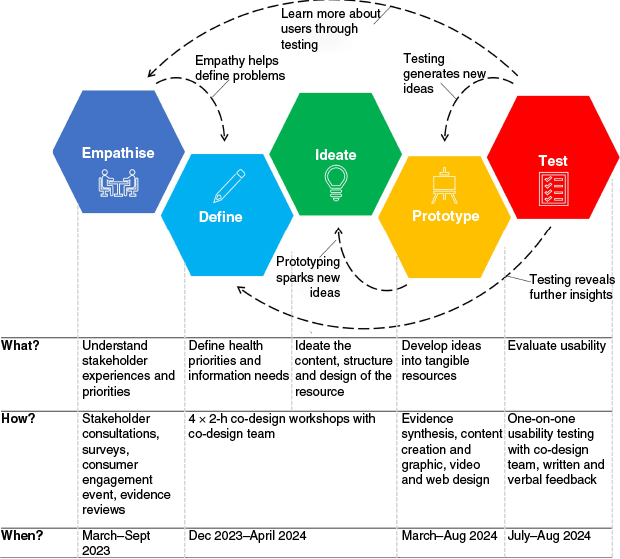
A Steering Committee was formed at study commencement to oversee study progress. Members included clinician researchers working with older adults and people with brain injury (n = 4), researchers in brain injury and disability (n = 5), representatives of stakeholder and funding organisations (n = 4), and a consumer representative with lived experience as a family member of a person with a brain injury. The clinician researchers and researchers were based at research centres in NSW, Victoria and Western Australia where previous research has been conducted on TBI and ageing. The stakeholder/funder representatives were from the two Australian injury compensation agencies in NSW and Victoria who funded the research. The consumer representative was an experienced consumer advisor from the Rehabilitation, Ageing and Independent Living (RAIL) Research Centre in Victoria.
Ethics approval was received from the University of Sydney Human Research Ethics Committee (2023/374) prior to the project commencing. Participants of surveys, the consumer engagement event, and co-design workshops all provided informed consent. All consumers and expert clinicians who participated in the co-design workshops were compensated for their time at an hourly rate consistent with the University’s compensation guidelines.
Stage 1 (‘empathise’)
Stage 1 of the project aimed to understand the experiences and priorities of stakeholders in ageing and brain injury, and included four methods: (1) consultations with stakeholder organisations in Victoria and NSW; (2) a survey of older adults (aged 55+ years) with TBI and their families/carers; (3) an online consumer engagement event; and (4) extraction of findings from two prior evidence reviews conducted by the researchers on ageing with TBI (Ekegren et al. 2020b; Cameron and Kurrle 2021).
Representatives from ageing and brain injury stakeholder organisations in Victoria and NSW were invited by members of the Project Steering Committee, via their public domain contact details, to provide written and verbal feedback on the proposed resource and the issues faced by older adults with a brain injury. Five representatives from stakeholder organisations provided feedback. These individuals were a manager at a national brain injury organisation in Queensland, a manager at a NSW government health organisation, and three experienced clinicians from three separate brain injury health services (a speech pathologist in Victoria, a social worker in NSW and a physiotherapist in Victoria), one of whom was also a family member of a person with brain injury. Key issues highlighted included difficulties navigating insurance and health systems, financial challenges, discontinuity of care, lack of health system support for long-term care after TBI, limited information-seeking behaviour of people with TBI and/or their carers, the impact of physical disabilities, and the cognitive and comorbidity challenges in older adults with TBI.
Two online surveys were developed in a customised Research Electronic Data Capture (REDCap) database: one for older adults with a brain injury (aged 55+ years) and the other for families/carers of such individuals (Supplementary Files S2 and S3) (Harris et al. 2009, 2019). The age limit of 55+ years, rather than 65+ years which is more commonly used for older adults, was in recognition of the finding that age-related issues may emerge at a younger age in people with TBI (Griesbach et al. 2018). The surveys were developed based on the common conditions identified in the investigators’ previous studies on ageing with TBI and then piloted with members of the Steering Committee (Ekegren et al. 2020b; Cameron and Kurrle 2021). Invitations to complete the online surveys were disseminated via Connectivity Traumatic Brain Injury Australia’s website (www.connectivity.org.au), brain injury stakeholder organisations and members of the Steering Committee, and remained open from July to September 2023. Informed consent was implied via survey completion. Given the survey was exploratory in design, there was no predefined sample size for the survey. The surveys sought information on participant demographics and health issues experienced. The survey also included an invitation to join the online consumer engagement event, with participants prompted to provide their contact details if interested. Fig. 2 depicts the flow of participants from the survey to subsequent stages of the research.
A total of seven people responded to the online survey: five older adults (aged 55+ years) with a brain injury and two family members/carers of people ageing with a brain injury. Their characteristics are presented in Supplementary File S4. The majority of older adults with a TBI were male (n = 3), aged 55–60 years (n = 3), and were 6–10 years post injury (n = 3). Brain injury severity was reported as mild (n = 2), severe (n = 2), or unknown (n = 1). Both family members/carers were female, aged 71–80 years. In total, 36 unique health issues were identified by older adults with a TBI, with the most commonly identified issues being heart/circulation problems; sleep apnoea/diagnosed sleep disordered breathing problems; and problems related to muscles or bones, fatigue, and pain. There were eight health issues/needs identified by family/carers, most commonly hearing impairment, heart problems, and surgery.
Participants (older adults with a brain injury (aged 55+ years) as well as families/carers of older adults with a brain injury) were recruited for the online consumer engagement event via the online surveys, as well as through the professional and disabled persons’ networks of Steering Committee members. People who were unable to communicate effectively in English were excluded. People with a moderate to severe cognitive impairment who were unable to consent for themselves without a family member or carer who could consent on their behalf were also excluded.
After expressing an interest in attending the consumer engagement event, a researcher telephoned potential participants to discuss the research, subsequently mailing or emailing the explanatory statement and consent form. All participants provided written informed consent prior to their attendance at the consumer engagement event. Whether or not a person with moderate to severe cognitive impairment could consent for themselves was determined through liaison with the participant’s next of kin or carer, who was asked to confirm the participant’s eligibility and willingness to participate in the study by signing and returning the consent form. Our target for recruitment was 8–15 consumers (older adults with TBI and their families/carers) ideally with diversity of age, gender, injury severity, ethnicity, and level of physical and cognitive ability.
This 2-h event, hosted and recorded (with permission) via Zoom (version 6.1.12), sought to establish key considerations for the design and content of the resource. It was attended by three older adults with lived experience of TBI and two family members of people with TBI, and their characteristics are presented in Supplementary File S5. The event was facilitated and supported by three researchers (LC, CMB, CE), one of whom had considerable experience with facilitating co-design workshops (LC). Participants brainstormed and shared experiences of common health issues, helpful existing resources, organisations and health care professionals, information and support needs, what to include in the resource, and the preferred format for the resource. Break-out rooms and visualisation tools (Google Jamboards) were used to run the event and collect data (Fig. 3). These methods were informed by previous research on online co-design approaches developed and tested during the COVID-19 pandemic (Davis et al. 2021).
Researchers from the current study had previously conducted evidence reviews in 2020–21 on ageing with TBI (Ekegren et al. 2020a, 2020b; Cameron and Kurrle 2021). Information was extracted from these reviews about the prevalence of specific health conditions in people with TBI and evidence regarding their management to inform the development of a list of suitable topics and interventions for potential inclusion in the resource.
Stages 2 and 3 (‘define’ and ‘ideate’)
Stages 2 and 3 aimed to define the health priorities and information needs of consumers, as well as ideate the content, structure, and design of the resource. These stages were conducted via co-design workshops involving consumers (older adults with lived experience of TBI and their family members) and clinicians. A sub-group of two to four consumers from the online consumer engagement event were targeted for recruitment. These individuals were purposively sampled based on diversity of age, gender, level of physical and cognitive ability, and geographic location, as well as their suitability for participating in intensive co-design activities. Two clinicians with experience working with people with TBI were also targeted for recruitment to the co-design team, ideally with diversity of age, experience, and clinical discipline. These individuals were identified via the professional networks of Steering Committee members. The same informed consent procedures were followed as those used for the consumer engagement event.
The co-design team was established in November 2023, and their characteristics are provided in Supplementary File S6. The five-person team included a man and a woman with lived experience of ageing with TBI (recruited from the online consumer engagement event), the wife of a person with a TBI (recruited from within our Steering Committee), and two male clinicians: a rehabilitation physician and neuropsychologist (recruited via contacts of the Steering Committee). Of the five team members, two were from NSW (one from a rural area) and three were from Victoria.
From December 2023 to April 2024, the co-design team participated in four, 2-h, online co-design workshops via Zoom (version 6.1.12). It was necessary to host the workshops online given the geographically diverse locations of participants. Workshops were facilitated and supported online by two researchers (CE and CMB) and recorded, with permission, via Zoom. Another researcher (LC) provided in-person support to one of the co-design team members with TBI in their home to overcome issues with digital access and to support their active involvement. As with the consumer engagement event, break-out rooms and visualisation tools (Google Jamboards) were used to run the event and collect data. To minimise fatigue, rest breaks were incorporated into every workshop so that no session lasted more than 45 min. Rest breaks were also tailored to the group dynamic and the expressed needs of individuals.
At the start of the first workshop, ‘ice-breaker’ activities were run to help participants get to know each other, with each co-design team member sharing one of their favourite memories with the group. These ice-breaker activities were deliberately non-hierarchical with consumers, clinicians, and researchers all participating equally. At the start of the first workshop, participants were also given an overview and explanation of the principles of successful co-design, including equal partnerships, openness, respect, empathy, and ‘design together’ (Australian Healthcare and Hospitals Association (AHHA) and Consumers Forum of Australia (CHF) 2019).
This workshop focussed on the design, format, and title of the resource. Participants were shown a series of example resources and asked to identify what they liked and what they didn’t like. Participants voiced a preference for resources with bright, primary colours; large font; humour; and plain language. They reported liking notes sections, diagrams, and other interactive components (e.g. checklists) but disliking quizzes and knowledge checks. They highlighted the importance of providing the resource both electronically and in hard copy. They also came up with the name, 'Tools for ageing well with traumatic brain injury'.
This workshop focussed on the content of the resource. The co-design team brainstormed a list of health issues, resources, and support organisations for inclusion in the resource. Then a series of online Zoom polls were launched to enable the team to vote on the most important topics for inclusion. Highly ranked topics included managing memory changes when ageing, access to support and funding, medication management, and mental health.
This worshop focussed on seeking feedback on a draft template of the resource. The co-design team was presented with the final topics for inclusion and how they would be organised and presented within the resource. Consensus was reached on the selection, naming, and organisation of the topics, which enabled the researchers to commence work on content development.
One week prior to workshop four, each member of the co-design team was sent a draft of the resource. They were each asked to select up to three topics of their choosing to review in-depth, as well as provide some general feedback about the content and organisation of the resource. Workshop four was held with consumers and clinicians separately in order to collect more in-depth, group-specific feedback. Feedback enabled further refinement of content and wording as the researchers worked towards creating a final prototype for the graphic designer.
Stage 4 (‘prototype’)
The prototyping stage was undertaken from March to August 2024 and aimed to develop ideas into tangible resources. The researchers synthesised the evidence collected from stages 1–3 by reviewing all data sources, including workshop notes and transcripts. Peer-reviewed and grey literature was also retrieved on topics and content identified as a priority within stages 1–3. The researchers subsequently developed draft content for the resource, with sections reviewed by the Steering Committee and other subject matter experts, including speech pathologists and physical activity researchers, which subsequently underwent several iterations. Text editing software (e.g. Hemingway Editor, https://hemingwayapp.com/) was used to transform content that was first developed at a high-level of complexity to a Grade 8 readability level. The content development stage took 12 weeks.
A graphic designer was then engaged to design the resource in collaboration with the researchers. Several meetings and email interactions were undertaken to progress and refine the design, which took place over a subsequent 8-week period.
In March 2024, a video production team was engaged to develop two consumer stories and a short, animated overview of the resource. Two consumers (a person with lived experience of a TBI and a family member of a person with a TBI) who had participated in the online engagement event were invited to participate. Their stories were filmed in June 2024, with all videos finalised in August 2024 for upload to the website.
In the early stages of the project, Connectivity Traumatic Brain Injury Australia, an Australian not-for-profit organisation, offered to host the resource on their website (www.connectivity.org.au). Initial meetings with the web developer were held in July 2024, and a draft template of the webpage was produced in August 2024.
Stage 5 (‘test’)
In this user-testing stage (July 2024), each of the five members of the co-design team participated in a one-on-one user-testing session with one of the researchers (CE or CMB) to evaluate the usability of the drafted resource. Two versions of the resource were presented to the participants: one which was less spaced out with smaller font (version 1) and one which was more spaced out with larger font (version 2). The participants were asked which version they preferred and why. Participants voiced a preference for version 2 as they found it easier to read.
Using this version, the participants completed usability tests in accordance with the Pragmatic Usability Rating by Experts (PURE) method (Rohrer 2017). A series of four multi-stage tasks were designed by the research team to test the participant’s ability to use the draft resource, with each step of each task ranked by the researchers from 1 to 3 (based on ease of use). Mostly, tasks were completed easily by the participants (scoring 1) or with some effort (scoring 2), and there was little difference in total scores between participants. Given the slight difficulty some participants had with locating particular information, changes were made to the wording, size, and appearance of headings. Changes were also made to the cover page, including colours and images.
Verbal and written feedback on the draft resource was also provided by each member of the Steering Committee. Feedback was generally positive from the members of the Steering Committee, with small changes made to the cover images and the wording of some sections. In addition, a new section on pain was added to the resource based on feedback from one of the Steering Committee members that pain is a considerable concern for people ageing with a brain injury.
Results of testing and feedback were incorporated into a brief for graphic and web designers to refine the final product. A final version of the resource was presented to and approved by the co-design team and Steering Committee. The web developer then commenced work on uploading the resource to the Connectivity Traumatic Brain Injury Australia website.
Resource
'Tools for ageing well with traumatic brain injury' was launched in September 2024 at the National Brain Injury Conference hosted by Brain Injury Australia. The resource consists of a plain-language printed manual (Ekegren et al. 2024) and online web version with downloadable text resources and videos (https://www.connectivity.org.au/living-with-tbi/tools-for-ageing-well/) to improve accessibility and cater for a range of learning styles and user preferences. The resource includes information to help older adults with TBI and their families/carers engage with health services; improve their capacity for monitoring, prevention, and self-management of age-related health conditions; navigate health care and funding systems and legal matters; and advocate proactively for their identified health care and support needs.
The final resource has nine sections, with each topic presented over one–two pages (Table 1). The resource is colourful and aims to offer a light-hearted feel (Fig. 4). It is illustrated with cartoons and photographs, representing the diversity of the targeted population. Rather than providing in-depth, detailed explanations of health issues, content focusses on practical strategies for identifying, managing, and seeking help for different issues. The ‘Tools and skills’ section of the resource provides a range of interactive diaries and planning tools to assist with self-management of specific issues, such as behavioural issues, memory, sleep quality, pain, and medication. The ‘Getting organised’ section contains information on legal matters, such as guardianship and accessing funding, as well as contact details for a range of external organisations who can assist with this. For carers of people who are ageing with a brain injury, there is information about how to access respite care and other assistance, including details of support organisations. Although the resource is written in an accessible style, specifically targeting older adults with TBI and their families/carers, it is also designed to be useful for health professionals to help them plan and deliver care collaboratively with older people with TBI, as well as for injury insurance managers to tailor claims support.
| Sections | Topics | |
|---|---|---|
| 1. Ageing with traumatic brain injury | ||
 | Definitions | |
| Why did we create ‘Tools for ageing well with traumatic brain injury’? | ||
| One of our contributors | ||
| Who is this resource for? | ||
| How do I use this resource? | ||
| What do we mean by ageing well? | ||
| Map of the brain | ||
| Frequently asked questions | ||
| 2. Physical health | ||
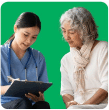 | Preventing falls | |
| Vision | ||
| Hearing | ||
| Pain | ||
| Digestion | ||
| Eating and swallowing | ||
| Bowel and bladder | ||
| 3. Mental health | ||
 | Behaviour | |
| Anxiety | ||
| Depressed mood | ||
| 4. Mind health | ||
 | Memory | |
| Cognition | ||
| Dementia | ||
| 5. Lifestyle | ||
 | Nutrition and weight management | |
| Physical activity | ||
| Participating more fully in life | ||
| Sleep | ||
| Fatigue | ||
| Alcohol and smoking | ||
| Sexuality | ||
| 6. Getting organised | ||
 | Legal options | |
| Power of Attorney, Guardianship, and advance care planning | ||
| Accessing extra support | ||
| Travel concessions | ||
| 7. For carers | ||
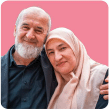 | What it might mean to care for someone ageing with a brain injury | |
| Caring for yourself as a carer | ||
| Respite care or short-term accommodation | ||
| 8. Tools and skills | ||
 | Planning | |
| Goal setting to help you age well | ||
| Health diaries | ||
| Fatigue management | ||
| Apps and other tools | ||
| 9. Where to get help | ||
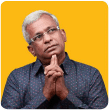 | Questions for your health professional | |
| Telehealth | ||
| Health professionals who can help to treat health issues associated with brain injury | ||
| Other professionals who may be helpful to you | ||
| Organisations providing funding, care and support to people with traumatic brain injury | ||
To aid in dissemination, a tri-fold brochure was printed, describing the resource and providing the weblink (Supplementary File S7). These were distributed at the 2024 National Brain Injury Conference; mailed to Australian brain injury units, community-based service providers, and residential aged care facilities; and displayed at community events targeting older adults and people with brain injury. A one-page reference guide for claims managers within the injury compensation schemes who funded the research was also produced.
Reflections and discussion
This report described the co-design and co-production of a consumer-led resource entitled, 'Tools for ageing well with traumatic brain injury' (Ekegren et al. 2024). Throughout the five-stage design-thinking process, input was sought from a variety of stakeholders and information sources using a variety of methodologies, including consultations with people with TBI, their families and health professionals; surveys; co-design workshops; and graphic and other multi-modal information design (Altman et al. 2018). This study adds to the growing literature on participatory designs and design-thinking approaches in health, emphasising the value of developing tailored health information ‘with’ and not ‘for’ the end-user (Abookire et al. 2020; Oliveira et al. 2021; Webber et al. 2022).
Throughout the study, the consumers who participated in the co-design workshops informally reported to researchers that they appreciated seeing their perspectives, ideas, and words included in the resource, contributing to a sense of ownership. They also expressed that they perceived meaning in their involvement, knowing that the end-product would help others in similar circumstances. The consumers reported that participating in co-design workshops and hearing others’ ideas helped them to reflect upon their own health and make improvements accordingly. Consumers noted that they empathised with and admired the others in the group, and they enjoyed hearing lived experiences from people with TBI and their families that mirrored their own, as well as learned experiences from health professionals. These perspectives align with previous studies indicating that participatory approaches can enhance feelings of agency, personal growth, and social connectivity in end-users (D’Cruz et al. 2022; Webber et al. 2022). For researchers, the co-design approach instilled a sense of confidence in the relevance and value of the end-product. Although it was beyond the scope of this study to conduct a formal qualitative investigation of consumers’ experiences of participating in the study, this would provide a greater understanding of whether consumers felt their voices and perspectives were appropriately and adequately considered throughout the study.
One of the key challenges in developing the resource was achieving a balance between content that was detailed enough to be useful, yet still able to be easily understood by people with TBI and their families. The five-stage design-process was key to overcoming this challenge, as its non-linearity enabled feedback sought from consumers in later stages to be integrated into earlier content generation stages, ensuring constant iteration and improvement of the resource throughout the project. In addition, the PURE method (Rohrer 2017) aided useability testing and evidenced experiences across different stakeholders who were anticipated to access the tools, including people with TBI and their families as well as health professionals working with them.
At times, it was challenging for the research team to balance the experiences and levels of knowledge of different stakeholder groups within the co-design team (i.e. consumers and experienced health professionals). For example, one participant expressed frustration when the discussion became overly technical and beyond their level of comprehension. It was for this reason that, in the final workshop where detailed content feedback was sought, separate sessions were held for clinicians and consumers. However, on the whole, the consumers and clinicians were highly respectful of their differences and sensitive to each other’s perspectives, which was testament to the purposive selection of appropriate participants for the co-design team and the introduction to co-design principles of respect and empathy at an early stage. This challenge of aligning varied stakeholder groups has been highlighted in previous co-design studies, which emphasise that adopting a non-hierarchical, collaborative approach and ensuring all opinions are heard, are essential elements for overcoming differences (Webber et al. 2022).
Although this study demonstrated the potential and value of using co-design and co-production to develop a resource for ageing well with brain injury, some limitations also existed. Firstly, the two people with brain injury who were recruited for the co-design team were experiencing relatively mild to moderate cognitive, communication, and physical impairments at the time of the project (despite having initially experienced severe TBIs). One of these individuals was still working, and both were living independently in the community, albeit with support from family and health professionals. To understand the experiences of people with more severe or enduring impairments, we recruited a close family member of a person who had lived with the effects of a severe TBI for over 30 years, as well as two clinicians with many years of experience working with people across the full spectrum of brain injury outcomes. However, it is acknowledged that representation of people with severe TBI by proxy may not adequately capture the authentic lived experience of this condition. The challenge of achieving true inclusivity in participatory research, particularly in the presence of cognitive and communication impairments, has previously been noted with feasibility often a limiting factor (D’Cruz et al. 2022). Using alternate forms of engagement, such as one-on-one, offline co-design sessions, may have helped to improve the diversity of the group. In addition, although our recruitment strategies were broad, including contacting clinicians who treat people with severe injury, other strategies to increase recruitment of people with cognitive and communication impairments may have been beneficial, such as using offline recruitment methods (e.g. via newsletters) and inviting people with brain injury to participate alongside a supporter (Topping et al. 2021).
Secondly, the online format of co-design workshops, which was necessitated by the geographic diversity of our sample, did pose challenges. These included issues with internet connectivity for one participant, as well as difficulties conducting creative tasks in a virtual environment. To address the former challenge, once it was realised that connectivity was an issue, a member of our research team provided in-person support and a dedicated mobile wi-fi connection. For the latter challenge, we used a series of tools, including Google Jamboards for notetaking, Zoom polling for consensus work, and break-out rooms for smaller group tasks where possible. Training was provided to participants by facilitators to support the use of these digital tools. We also provided regular breaks to avoid digital fatigue.
Finally, the sample of survey respondents was smaller than expected, and for the online consumer engagement event, we did not meet the planned recruitment target of 8–15 consumers. Given known challenges in recruiting people with TBI, we adopted a pragmatic approach, recruiting as many consumers as possible for these stages within the study timeframe. Although the sample recruited for our co-design team was relatively small (three consumers, two clinicians, and three facilitators), this was in line with our targeted sample size and meant that it was possible to be inclusive in discussions, allowing all voices to be heard.
As the first Australian resource of its kind, 'Tools for ageing well with traumatic brain injury' aims to assist older adults with TBI and their carers to proactively plan for ageing well with TBI. The resource seeks to increase personal health literacy, knowledge, and self-management skills surrounding health issues, and promote recreational, social, and community participation. The resource also includes locally relevant information about accessing funding for care and support. Throughout the study, funding was highlighted as a key issue for older adults with TBI, and has previously been noted to be extremely complex in Australia, dependent on age, injury mechanism and state-based injury compensation policies (Schwarzman et al. 2022).
It is recognised that, on its own, the provision of health information is unlikely to significantly enhance health literacy or improve health outcomes (Sander et al. 2024). However, this resource plays a vital role as part of a broader set of strategies. Improvements in health literacy can also be fostered through the use of effective, sensitive and evidence-based communication techniques by health care professionals, involvement of families and carers in health care discussions, provision of patient-centred care, and the development and implementation of interventions to promote health-related self-efficacy (Liu et al. 2020). There is also a role for education systems to play in improving general literacy skills, health systems in improving health care access, and governments in addressing social inequalities (Sander et al. 2024). Future research is warranted to develop and evaluate interventions aimed at improving health literacy and health outcomes in older adults with TBI. Furthermore, studies are needed that provide a greater understanding between measurable health literacy and health outcomes in the years following TBI (Sander et al. 2024).
In conclusion, this study has highlighted the value of co-design and co-production in developing a resource that was directly informed by people with brain injury and their families/carers. The comprehensive five-stage design-thinking process maximised the range of evidence sources and perspectives integrated into the end-product. Although it was a challenge to balance diverse stakeholder perspectives in the development of the resource, following the key principles of co-design, particularly openness, respect, and empathy, ensured that the process was both effective and reportedly enjoyable for participants and researchers. Future research should explore uptake and utility of this co-designed resource, as well as its impact on health outcomes, social participation, and sustained behaviour change in people with brain injury and their families/carers.
Data availability
Data used to generate the results in the paper are not available, as this provision was not provided within our ethics approval.
Declaration of funding
This research was co-funded by icare NSW (Ageing with a traumatic brain injury consumer resources) and the Transport Accident Commission (TAC), Victoria (T097 Ageing with a traumatic brain injury consumer resources). The funders had no involvement in the preparation of the data or manuscript or the decision to submit for publication.
Ethics
Ethics approval was received by the University of Sydney Human Research Ethics Committee (2023/374) and all participants provided informed consent.
Acknowledgements
The investigators gratefully acknowledge the input of members of the Steering Committee: Professor Melinda Fitzgerald (Connectivity Traumatic Brain Injury Australia), Professor Susan Kurrle (University of Sydney), Jade Hurst (TAC), and Jeffrey Tonge (icare NSW); consumer and clinician co-designers: Bernard Chandra, Tony Housden, Raylene West, Thomas Gates, Lisa Licciardi, and Professor John Olver; other contributors: Clare Douglas (Victorian Neurorehabilitation Network), Associate Professor Leanne Hassett (University of Sydney), Dr Aleksandra Gozt and Naomi Fuller (Connectivity Traumatic Brain Injury Australia), and Rhys Ashpole and Rebecca Jackson (icare NSW); and suppliers: Ingrid Horton (graphic designer), Pure Production (video production) and key2 Creative (web development). We thank Connectivity Traumatic Brain Injury Australia for funding and hosting the web version of the resource.
References
Abookire S, Plover C, Frasso R, Ku B (2020) Health Design Thinking: An Innovative Approach in Public Health to Defining Problems and Finding Solutions. Frontiers in Public Health 8, 459.
| Crossref | Google Scholar | PubMed |
Altman M, Huang TTK, Breland JY (2018) Design Thinking in Health Care. Preventing Chronic Disease 15, E117.
| Crossref | Google Scholar | PubMed |
Auernhammer J, Roth B (2021) The origin and evolution of Stanford University’s design thinking: From product design to design thinking in innovation management. Journal of Product Innovation Management 38, 623-644.
| Crossref | Google Scholar |
Australian Healthcare and Hospitals Association (AHHA) Consumers Forum of Australia (CHF) (2019) Experience based co-design - a toolkit for Australia. Available at https://ahha.asn.au/experience-based-co-design-toolkit [accessed 12 July 2019]
Beck B, Bray JE, Cameron PA, Cooper DJ, Gabbe BJ (2016) Trends in severe traumatic brain injury in Victoria, 2006–2014. Medical Journal of Australia 204, 407.
| Crossref | Google Scholar | PubMed |
Blomkamp E (2018) The Promise of Co-Design for Public Policy. Australian Journal of Public Administration 77, 729-743.
| Crossref | Google Scholar |
Cameron ID, Kurrle SE (2021) ‘Review of Ageing and End of Life Issues for People with an Acquired Injury.’ (icare: Sydney) Available at https://www.researchgate.net/publication/369089210_Review_of_Ageing_and_End_of_Life_Issues_Report
Corrigan JD, Hammond FM (2013) Traumatic Brain Injury as a Chronic Health Condition. Archives of Physical Medicine and Rehabilitation 94, 1199-1201.
| Crossref | Google Scholar | PubMed |
Davis A, Gwilt I, Wallace N, Langley J (2021) Low-Contact Co-Design: Considering More Flexible Spatiotemporal Models for the Co-Design Workshop. Strategic Design Research Journal 14, 124-137.
| Crossref | Google Scholar |
D’Cruz K, Antonopoulos S, Rothman R, Douglas J, Winkler D, Oliver S (2022) Co-designing with adults with acquired neurological disability in the community: a scoping review protocol. BMJ Open 12, e064921.
| Crossref | Google Scholar | PubMed |
Ekegren C, Lalor A, Schwarzman J, Aburumman M (2020a) Ageing with lifelong accident injuries - Environmental Scan. Final report for the TAC. (Monash University: Melbourne) Available at https://research.monash.edu/en/publications/t034-ageing-with-lifelong-accident-injuries-environmental-scan
Ekegren C, Schwarzman J, Aburumman M (2020b) Ageing with lifelong accident injuries - Evidence Review. Final report for the TAC. (Monash University: Melbourne) Available at https://research.monash.edu/en/publications/t034-ageing-with-lifelong-accident-injuries-evidence-review
Ekegren CL, McBain C, Callaway L, Gill L, Simpson GK, Cameron ID (2024) ‘Tools for ageing well with traumatic brain injury.’ (Sydney, Australia) Available at https://www.connectivity.org.au/living-with-tbi/tools-for-ageing-well/
Federman AD, Sano M, Wolf MS, Siu AL, Halm EA (2009) Health literacy and cognitive performance in older adults. Journal of the American Geriatrics Society 57, 1475-1480.
| Crossref | Google Scholar | PubMed |
Flanagan SR, Hibbard MR, Gordon WA (2005) The impact of age on traumatic brain injury. Physical Medicine and Rehabilitation Clinics of North America 16, 163-177.
| Crossref | Google Scholar | PubMed |
Greenhalgh T, Jackson C, Shaw S, Janamian T (2016) Achieving Research Impact Through Co-creation in Community-Based Health Services: Literature Review and Case Study. Milbank Quarterly 94, 392-429.
| Crossref | Google Scholar | PubMed |
Griesbach GS, Masel BE, Helvie RE, Ashley MJ (2018) The Impact of Traumatic Brain Injury on Later Life: Effects on Normal Aging and Neurodegenerative Diseases. Journal of Neurotrauma 35, 17-24.
| Crossref | Google Scholar | PubMed |
Hahn EA, Magasi SR, Carlozzi NE, Tulsky DS, Wong A, Garcia SF, Lai J-S, Hammel J, Miskovic A, Jerousek S, Goldsmith A, Nitsch K, Heinemann AW (2017) Health and Functional Literacy in Physical Rehabilitation Patients. Health literacy Research and Practice 1, e71-e85.
| Crossref | Google Scholar | PubMed |
Hahn EA, Boileau NR, Hanks RA, Sander AM, Miner JA, Carlozzi NE (2020) Health literacy, health outcomes, and the caregiver role in traumatic brain injury. Rehabilitation Psychology 65, 401-408.
| Crossref | Google Scholar | PubMed |
Han SD, Boyle PA, James BD, Yu L, Bennett DA (2015) Poorer Financial and Health Literacy Among Community-Dwelling Older Adults With Mild Cognitive Impairment. Journal of Aging and Health 27, 1105-1117.
| Crossref | Google Scholar | PubMed |
Harris PA, Taylor R, Thielke R, Payne J, Gonzalez N, Conde JG (2009) Research electronic data capture (REDCap)—a metadata-driven methodology and workflow process for providing translational research informatics support. Journal of Biomedical Informatics 42, 377-381.
| Crossref | Google Scholar | PubMed |
Harris PA, Taylor R, Minor BL, Elliott V, Fernandez M, O’Neal L, McLeod L, Delacqua G, Delacqua F, Kirby J, Duda SN, on behalf of the REDCap Consortium (2019) The REDCap consortium: Building an international community of software platform partners. Journal of Biomedical Informatics 95, 103208.
| Crossref | Google Scholar | PubMed |
Hyder AA, Wunderlich CA, Puvanachandra P, Gururaj G, Kobusingye OC (2007) The impact of traumatic brain injuries: a global perspective. Neurorehabilitation 22, 341-53.
| Crossref | Google Scholar | PubMed |
Jourdan C, Azouvi P, Genêt F, Selly N, Josseran L, Schnitzler A (2018) Disability and Health Consequences of Traumatic Brain Injury: National Prevalence. American Journal of Physical Medicine & Rehabilitation 97, 323-331.
| Crossref | Google Scholar | PubMed |
Liu C, Wang D, Liu C, Jiang J, Wang X, Chen H, Ju X, Zhang X (2020) What is the meaning of health literacy? A systematic review and qualitative synthesis. Family Medicine and Community Health 8, e000351.
| Crossref | Google Scholar | PubMed |
Maas AIR, Menon DK, Adelson PD, Andelic N, Bell MJ, Belli A, Bragge P, Brazinova A, Büki A, Chesnut RM, Citerio G, Coburn M, Cooper DJ, Crowder AT, Czeiter E, Czosnyka M, Diaz-Arrastia R, Dreier JP, Duhaime A-C, Ercole A, van Essen TA, Feigin VL, Gao G, Giacino J, Gonzalez-Lara LE, Gruen RL, Gupta D, Hartings JA, Hill S, Jiang J-y, Ketharanathan N, Kompanje EJO, Lanyon L, Laureys S, Lecky F, Levin H, Lingsma HF, Maegele M, Majdan M, Manley G, Marsteller J, Mascia L, McFadyen C, Mondello S, Newcombe V, Palotie A, Parizel PM, Peul W, Piercy J, Polinder S, Puybasset L, Rasmussen TE, Rossaint R, Smielewski P, Söderberg J, Stanworth SJ, Stein MB, von Steinbüchel N, Stewart W, Steyerberg EW, Stocchetti N, Synnot A, Te Ao B, Tenovuo O, Theadom A, Tibboel D, Videtta W, Wang KKW, Williams WH, Wilson L, Yaffe K, InTBIR Participants and Investigators (2017) Traumatic brain injury: integrated approaches to improve prevention, clinical care, and research. The Lancet Neurology 16, 987-1048.
| Crossref | Google Scholar | PubMed |
McDougall, S (2012) ‘Co-production, co-design and co-creation: what is the difference?’ (Stakeholder Design) Available at https://www.stakeholderdesign.com/about/co-production-versus-co-design-what-is-the-difference/
Nutbeam D (2008) The evolving concept of health literacy. Social Science and Medicine 67, 2072-2078.
| Crossref | Google Scholar | PubMed |
Oliveira M, Zancul E, Fleury AL (2021) Design thinking as an approach for innovation in healthcare: systematic review and research avenues. BMJ Innovations 7, 491-498.
| Crossref | Google Scholar |
Pozzato I, Tate RL, Rosenkoetter U, Cameron ID (2019) Epidemiology of hospitalised traumatic brain injury in the state of New South Wales, Australia: a population-based study. Australian and New Zealand Journal of Public Health 43, 382-388.
| Crossref | Google Scholar | PubMed |
Rohrer C (2017) Quantifying and Comparing Ease of Use Without Breaking the Bank. Available at https://www.nngroup.com/articles/pure-method/ [accessed 20 August 2024]
Sander AM, Pappadis MR, Juengst SB, Leon-Novelo L, Ngan E, Corrigan JD, Dreer LE, Driver S, Lequerica AH (2024) Characterizing Health Literacy and Its Correlates Among Individuals With Traumatic Brain Injury (TBI): A TBI Model Systems Study. The Journal of Head Trauma Rehabilitation 39, 95-102.
| Crossref | Google Scholar | PubMed |
Sanders EBN, Stappers PJ (2008) Co-creation and the new landscapes of design. CoDesign 4, 5-18.
| Crossref | Google Scholar |
Schwarzman J, Lalor A, Reeder S, Callaway L, Aburumman M, Gabbe BJ, Ekegren CL (2022) Factors influencing care and support for older adults with traumatic injury in Australia: a qualitative study. Disability and Rehabilitation 44, 6692-6698.
| Crossref | Google Scholar | PubMed |
Staniszewska S, Brett J, Simera I, Seers K, Mockford C, Goodlad S, Altman DG, Moher D, Barber R, Denegri S, Entwistle A, Littlejohns P, Morris C, Suleman R, Thomas V, Tysall C (2017) GRIPP2 reporting checklists: tools to improve reporting of patient and public involvement in research. BMJ 358,.
| Crossref | Google Scholar | PubMed |
Taggart J, Williams A, Dennis S, Newall A, Shortus T, Zwar N, Denney-Wilson E, Harris MF (2012) A systematic review of interventions in primary care to improve health literacy for chronic disease behavioral risk factors. BMC Family Practice 13,.
| Crossref | Google Scholar | PubMed |
Topping M, Douglas J, Winkler D, 16094069211019615 (2021) General Considerations for Conducting Online Qualitative Research and Practice Implications for Interviewing People with Acquired Brain Injury. International Journal of Qualitative Methods 20,.
| Crossref | Google Scholar |
Webber R, Partridge R, Grindell C (2022) The creative co-design of low back pain education resources. Evidence & Policy 18, 436-453.
| Google Scholar |


